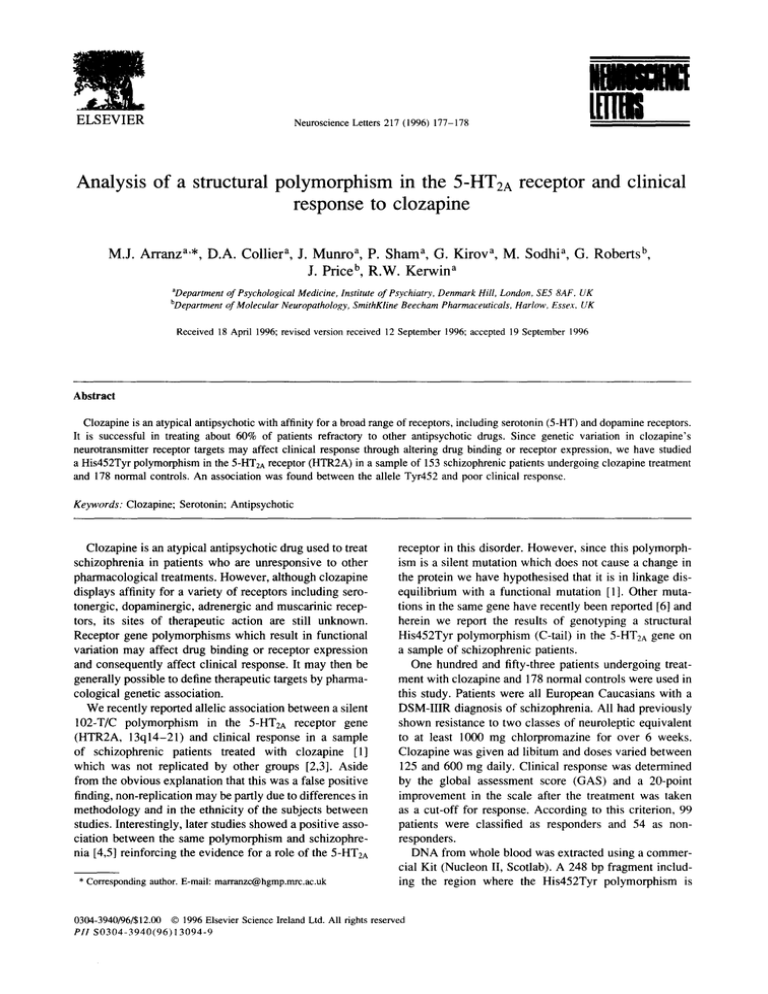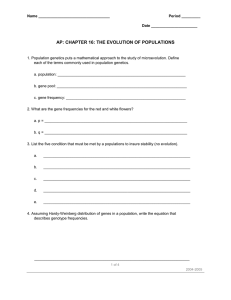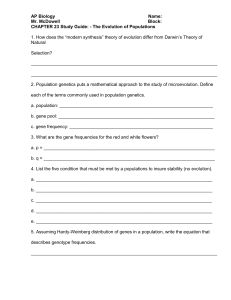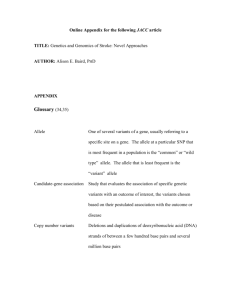
ELSEVIER
Neuroscience Letters 217 (1996) 177-178
I[llll
Analysis of a structural polymorphism in the 5-HT2A receptor and clinical
response to clozapine
M.J. Arranz a'*, D.A. Collier a, J. Munro a, P. Sham a, G. Kirov a, M. Sodhi a, G. Roberts b,
J. Price b, R.W. Kerwin a
aDepartment of Psychological Medicine, Institute of Psychiatry, Denmark Hill, London, SE5 8AF. UK
bDepartment of Molecular Neuropathology, SmithKline Beecham Pharmaceuticals, Harlow, Essex, UK
Received 18 April 1996; revised version received 12 September 1996; accepted 19 September 1996
Abstract
Clozapine is an atypical antipsychotic with affinity for a broad range of receptors, including serotonin (5-HT) and dopamine receptors.
It is successful in treating about 60% of patients refractory to other antipsychotic drugs. Since genetic variation in clozapine's
neurotransmitter receptor targets may affect clinical response through altering drug binding or receptor expression, we have studied
a His452Tyr polymorphism in the 5-HT2Areceptor (HTR2A) in a sample of 153 schizophrenic patients undergoing clozapine treatment
and 178 normal controls. An association was found between the allele Tyr452 and poor clinical response.
Keywords." Clozapine; Serotonin; Antipsychotic
Clozapine is an atypical antipsychotic drug used to treat
schizophrenia in patients who are unresponsive to other
pharmacological treatments. However, although clozapine
displays affinity for a variety of receptors including serotonergic, dopaminergic, adrenergic and muscarinic receptors, its sites of therapeutic action are still unknown.
Receptor gene polymorphisms which result in functional
variation may affect drug binding or receptor expression
and consequently affect clinical response. It may then be
generally possible to define therapeutic targets by pharmacological genetic association.
We recently reported allelic association between a silent
102-T/C polymorphism in the 5-HT2A receptor gene
(HTR2A, 13q14-21) and clinical response in a sample
of schizophrenic patients treated with clozapine [1]
which was not replicated by other groups [2,3]. Aside
from the obvious explanation that this was a false positive
finding, non-replication may be partly due to differences in
methodology and in the ethnicity of the subjects between
studies. Interestingly, later studies showed a positive association between the same polymorphism and schizophrenia [4,5] reinforcing the evidence for a role of the 5-HT2A
* Corresponding author. E-mail: marranzc@hgmp.mrc.ac.uk
receptor in this disorder. However, since this polymorphism is a silent mutation which does not cause a change in
the protein we have hypothesised that it is in linkage disequilibrium with a functional mutation [1]. Other mutations in the same gene have recently been reported [6] and
herein we report the results of genotyping a structural
His452Tyr polymorphism (C-tail) in the 5-HT2A gene on
a sample of schizophrenic patients.
One hundred and fifty-three patients undergoing treatment with clozapine and 178 normal controls were used in
this study. Patients were all European Caucasians with a
DSM-IIIR diagnosis of schizophrenia. All had previously
shown resistance to two classes of neuroleptic equivalent
to at least 1000 mg chlorpromazine for over 6 weeks.
Clozapine was given ad libitum and doses varied between
125 and 600 mg daily. Clinical response was determined
by the global assessment score (GAS) and a 20-point
improvement in the scale after the treatment was taken
as a cut-off for response. According to this criterion, 99
patients were classified as responders and 54 as nonresponders.
DNA from whole blood was extracted using a commercial Kit (Nucleon II, Scotlab). A 248 bp fragment including the region where the His452Tyr polymorphism is
0304-3940/96/$12.00 © 1996 Elsevier Science Ireland Ltd. All rights reserved
Pll S0304-3940(96)13094-9
178
Md. Arranz et al. / Neuroscience Letters 217 (1996) 177-178
located was amplified following the polymerase chain
reaction (PCR) methods described by Erdmann et al. [6]
with slight modifications. Briefly, amplification was performed using 100 ng of genomic DNA, 2.0 mM of MgCI2,
200 mM dNTPs, I#M of each primer and 1 U of Taq
polymerase. The PCR conditions were 35 cycles of 1' at
95°C, 45' at 58°C, 45' at 72°C with an additional elongation step of 10' at 72°C. The PCR products were then
digested with 10 U of BbvI at 37°C overnight. Allele
His452 was digested in two fragments of 180 bp and 68
bp, whereas allele Tyr452 was uncut. The fragments were
analysed in 3% agarose gels next to a DNA size standard.
Table 1 summarises the results. No differences were
observed between the genotype and allele frequencies in
the clozapine treated patients in comparison with controls.
However, the frequency of the Tyr452 allele was higher
among patients who did not respond to the treatment with
clozapine than in those who responded (11% versus 6%,
respectively). This effect was also evident if the Tyr452
allele was considered recessive (X2 = 2.84, P = 0.09), as
three out of four patients homozygous for the Tyr452
allele belonged to the group of non-responders. The results
reported by Noethen et al. [2] on this polymorphism were
not significant. However, retrospective analysis of
Noethen's data shows it to be consistent with our finding
as the only individual homozygous for the Tyr452 variant
showed poor response to clozapine. Because 5-HT2c has
Table 1
Genotype and allele frequencies of His452Tyr polymorphism in 5-HT2A
gene in clozapine-treated patients and controls
Responders
Non-responders
Controls
Genotype
His452/His452
His452/Tyr452
Tyr452/Tyr452
Total
87 (88)
11 (11)
1" (1)
99
45 (83)
6 (11)
3 (6)
54
153 (86)
21 (12)
4 (2)
178
185 (93.5)
13 (6.5)
198
96 (89)
12 (11)
108
327 (92)
29 (8)
Allele
His452
Tyr452
Total
*This patient has a Ser23 allele at the 5-HT2C receptor gene, not present
in the other three patients homozygous for Tyr452. Percentages are
indicated in parentheses.
been shown to be associated with good response [7] and
may confound the analysis, those patients with a Ser23
allele at 5-HT2c were excluded from the sample. Reanalysis of the data showed a stronger association between the
His452Tyr polymorphism and response to clozapine (X2
P = 0.07 for clinical response relative to genotype, X2
P = 0.02 for clinical response relative to genotype considering Tyr452 recessive and X2 P = 0.02 for clinical
response relative to allele frequency). Although these
results involve small numbers of subjects with allele
Tyr452 and need to be replicated to confirm the association, they reinforce the hypothesis that genetic variation in
neurotransmitter receptors alters clinical response to antipsychotic drugs. Taken together with other pharmacological data the results strengthen the candidacy for the 5-HTzA
receptor as an important therapeutic target in schizophrenia.
[1] Arranz, M.J., Collier, D., Sodhi, M., Ball, D., Roberts, G.W., Price,
J., Sham, P. and Kerwin, R., Association between clozapine
response and allelic variation in 5-HT2A receptor gene, Lancet,
346 (1995) 281-282.
[2] Noethen, M.M., Rietschel, M., Erdmann, J., Oberlander, H.,
Moiler, H.H., Naber, D. and Propping, P., Genetic variation of
the 5-HT2A receptor and response to clozapine, Lancet, 346
(1995) 908.
[3] Masellis, M., Paterson, A.D., Badri, F., Lieberman, J.A., Meltzer,
H.Y., Cavazzoni, P. and Kennedy, J.L., Genetic variation of the 5HT2A receptor and response to clozapine, Lancet, 346 (1995) 1108.
[4] Spurlock, G., Williams, J., Daniels, J., Owen, M. and McGuffin, P.,
The European multi-centre study of susceptibility gene associations
in schizophrenia: typing the 5HT-2R gene, Psychiatr. Genet., 5
(1995) $64.
[5] lnayama, Y., Yoneda, H., Sakai, T., Ishida, T., Nonomura, Y.,
Kono, Y., Takahata, R., Koh, J., Sakai, J., Takai, A., Inada, Y.
and Asaba, H., Positive association between a DNA sequence variant in the serotonin 2A receptor gene and schizophrenia, Am. J.
Med. Genet., 67 (1996) 103-105.
[6] Erdmarm, J., Shimron-Abarbanell, D., Rietschel, M., Albus, M.,
Maier, W., Koerner, J., Bondy Brigitta, B., Chen, K., Shih, J.C.,
Knapp, M., Propping, P. and Noethen, M., Systematic screening for
mutations in the human serotonin-2A (5-HT2A) receptor gene: identification of two naturally occurring receptor variants and association analysis in schizophrenia, Hum. Genet., (1996) in press.
[7] Sodhi, M., Arranz, M.J., Curtis, D., Ball, D.M., Sham, P., Roberts,
G.W., Price, J., Collier, D. and Kerwin, R., Association between
clozapine response and allelic variation in the 5-HT2c receptor
gene, NeuroReport, 7 (1995) 169-172.



